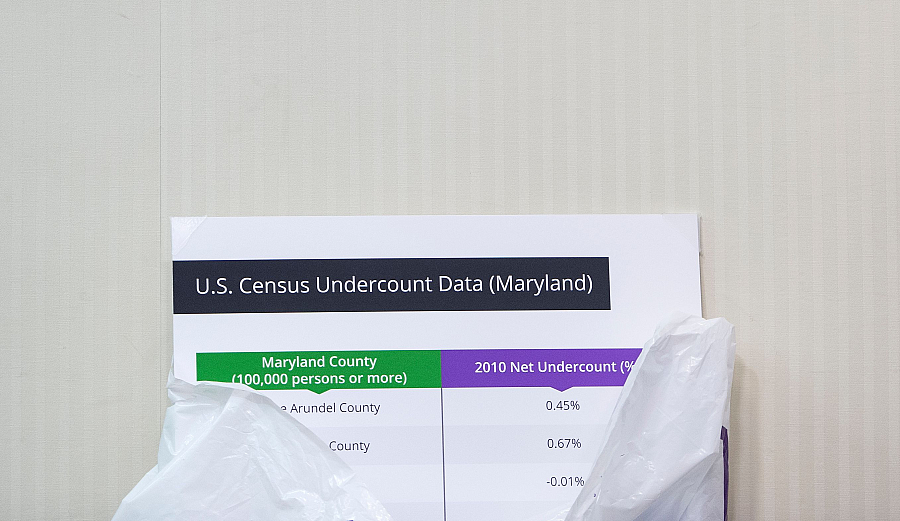Perspective: Census undercount a threat to vulnerable children’s health

(Photo: Brendan Smialowski/AFP/Getty Images)
The 2020 census is quickly approaching, and with it rising concern that this decade’s census could undercount the number of children in the U.S. Though the undercount of children isn’t a new issue, there are unique challenges facing the 2020 census that could make it a larger problem than in the past. As an epidemiologist and children’s health policy researcher, I’m concerned about the impact that these challenges could have on children’s health in the coming decade.
Conducting the once-per-decade census is a costly, labor-intensive endeavor, but the U.S. Census Bureau is making important strides to bring it into the 21st century. This includes allowing respondents to complete the census form online for the first time. Such changes, however, come with a steep price tag, forcing the Census Bureau to make tradeoffs in order to stay within the tight budget it has been recently given by Congress and the White House. It had to cancel two out of three scheduled census test runs this year, which would have given us data on how these new methods work in rural and suburban communities.
At the same time, the 2020 census will controversially ask respondents’ about their citizenship for the first time since the 1950s. While the Census Bureau is legally prohibited from sharing personal information with other government agencies, the perception of risk may dissuade people in immigrant communities from responding, increasing the likelihood of an undercount in immigrant communities.
Both of these issues make it all too possible that children will be undercounted in 2020. In 2010, the census missed nearly 1 million children ages zero to 4. Children can go uncounted for any number of reasons — for example, living in a household with multiple families or living at an unregistered address. Minority children or those who live in low-income families that rent are also more likely to be undercounted than their peers. The undercount of young children has increased over time, from 1.8 percent in 1980 to 4.6 percent in 2010.
So why should we be alarmed at the potential undercount of children in 2020?
Census data plays a vital role in determining funding levels for countless federal programs that create the foundation of public health in the United States. If children are undercounted in the census, then federal support for programs like Medicaid, Head Start, Women, Infants, and Children (WIC), foster care, and grants to local education agencies could fall short of on-the-ground need in states. These programs address essential social factors that shape children’s health; funding cuts mean they won’t be able to reach all of the children and families who rely on them.
Take Medicaid, for example. Each state receives funding from the federal government to support a portion of its annual Medicaid program costs. States with a lower per capita income receive more federal support because they theoretically have a larger Medicaid-eligible population. Per capita income is simply a state’s total income divided by the total population. If the census were to undercount the total population, it would artificially inflate per capita income, which could result in states receiving less federal support for their Medicaid programs. One estimate put states’ annual lost Medicaid funds at anywhere from $533 to $2,309 for each person uncounted by the census. Since Medicaid provides direct health care access for tens of millions of children and their parents in the U.S., the unmet health needs could be huge.
In public health, accurate population data is the foundation of every informed decision we make. We use it to examine disease prevalence, how disease trends are changing over time, and whether public health interventions are working. Epidemiologists use census data for everything from monitoring asthma hospitalization disparities to understanding populations affected by natural disasters like Hurricane Sandy. If the 2020 census doesn’t capture accurate population counts for children, it will become much more difficult to monitor children’s health trends in the coming decade.
Children uncounted by the census won’t get our help if we don’t know that they are there. As it stands, we’re risking a situation in which some children won’t be counted in the 2020 census by virtue of the economic or geographic circumstances they were born into. And if they’re not counted, they’ll have a harder time accessing the very services that can help kids surmount early disadvantages. This inequity is at the heart of why we need to take seriously the consequences of a possible undercount of children. Representation in the census is a right of everyone living in the U.S.; if we’re to achieve equitable health outcomes for children in this country, that right must be fulfilled for every child in 2020.
Doug Strane is an epidemiologist and children’s health policy researcher at PolicyLab at Children’s Hospital of Philadelphia. This blog post was adapted from his recent commentary in the American Journal of Public Health.

